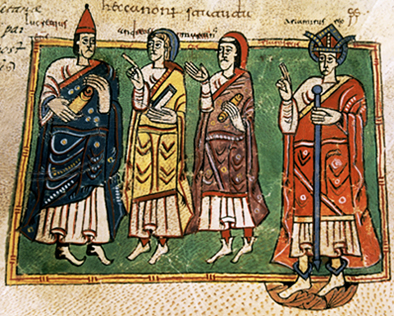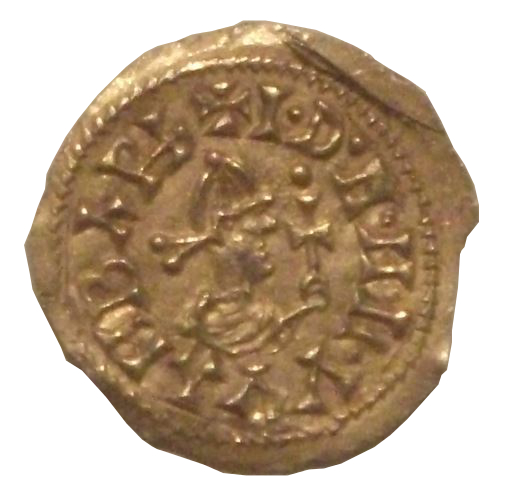|
Theodemund
Theodemund was a Suevic King of Galicia between the years 469 and 550. This period is very obscure and little is known about the rulers in this time save that they were Arians. The hypothesis of his existence is based on a twelfth-century document that mentions a ''Theodemundus'' ruling the Sueves between Remismund Remismund (or Rimismund) (died 469) was the Suevic king of Galicia from c. 464 until his death. According to Isidore of Seville, Remismund was a son of Maldras. Remismund's early career was spent as an ambassador between Galicia and Gaul, which tr ... and Theodomir. Because this mention occurs in a listing of seventh-century ecclesiastical divisions at the time of Wamba, Wilhelm Reinhart believes it was based on an earlier source. Sources *Arias, Jorge C"Identity and Interactions: The Suevi and the Hispano-Romans."University of Virginia: Spring 2007. {{Galician monarchs 6th-century Suebian kings 6th-century Arian Christians ... [...More Info...] [...Related Items...] OR: [Wikipedia] [Google] [Baidu] |
King Of Galicia
Galicia is an autonomous community and historical nationality in modern-day northwestern Spain on the Iberian Peninsula, which was a major part of the Roman province known as Gallaecia prior to 409. It consists of the provinces of A Coruña, Lugo, Ourense and Pontevedra. It is bounded on the north by the Cantabrian Sea, to the south by Portugal, to the west by the Atlantic Ocean and to the east by principality of Asturias and the community of Castile and León. The archipelago of the Cíes Islands, the Ons archipelago, the Sálvora archipelago and other island such as Cortegada, Arousa, the Sisargas Islands and the Malveiras Islands are also part of Galicia. Galicia has about 2,795,422 inhabitants which mainly combines the coastal strip between Ferrol and A Coruña in the northwest and between Vilagarcía de Arousa and Vigo in the southwest. The medieval and modern Kingdom of Galicia derived of the kingdom of the Suebi, founded by king Hermeric in 409. By the 6th centur ... [...More Info...] [...Related Items...] OR: [Wikipedia] [Google] [Baidu] |
Remismund
Remismund (or Rimismund) (died 469) was the Suevic king of Galicia from c. 464 until his death. According to Isidore of Seville, Remismund was a son of Maldras. Remismund's early career was spent as an ambassador between Galicia and Gaul, which trip he made several times.Thompson, 167. After an interregnum of approximately four years (460–464), during which the Sueves who had previously recognised Maldras as king were led by Frumar and those who had recognised Framta followed Rechimund while both their leaders fought for the throne, Remismund, returning from one of his embassies, succeeded in having himself recognised as king of a unified Suevic people. This occurred after Frumar's death, but scholars are not certain of the significance of that statement. Had Frumar become sole king? Or did Remismund initially succeed Frumar only over part of the Suevic nation? Furthermore, Remismund is sometimes identified with Rechimund. Remismund was confirmed in the kingship when the Visi ... [...More Info...] [...Related Items...] OR: [Wikipedia] [Google] [Baidu] |
Veremund
Veremund or Veremundus (later vernacular ''Vermudo'' or ''Bermudo'') was a Suevic king of Galicia around 500. His existence is conjectured on the basis of a sixth-century inscription discovered at Salvador de Vairão. The date in the inscription is interpreted as either 485 or 535. Some scholars have dated the inscription to the eighth century, arguing that the ''Veremundus'' of the inscription is King Bermudo I of Asturias. Veremund's reign would fall within a period of obscurity for the region of Galicia following the death of the valuable chronicler Hydatius (469) and the Sueves' conversion to Arianism (466). If the king existed, he was undoubtedly an Arian. Sources *Arias, Jorge C"Identity and Interactions: The Suevi and the Hispano-Romans."University of Virginia: Spring 2007. *Collins, Roger. ''Visigothic Spain, 409–711''. Oxford: Blackwell Publishing, 2004. . *Ferreiro, Alberto"Veremundu R(eg)e: revisiting an inscription from San Salvador de Vairão (Portugal)."''Zeitschr ... [...More Info...] [...Related Items...] OR: [Wikipedia] [Google] [Baidu] |
Suevi
The Suebi (or Suebians, also spelled Suevi, Suavi) were a large group of Germanic peoples originally from the Elbe river region in what is now Germany and the Czech Republic. In the early Roman era they included many peoples with their own names such as the Marcomanni, Quadi, Hermunduri, Semnones, and Lombards. New groupings formed later, such as the Alamanni and Bavarians, and two kingdoms in the Migration Period were simply referred to as Suebian. Although Tacitus specified that the Suebian group was not an old tribal group itself, the Suebian peoples are associated by Pliny the Elder with the Irminones, a grouping of Germanic peoples who claimed ancestral connections. Tacitus mentions Suebian languages, and a geographical "Suevia". The Suevians were first mentioned by Julius Caesar in connection with the invasion of Gaul by the Germanic king Ariovistus during the Gallic Wars. Unlike Tacitus he described them as a single people, distinct from the Marcomanni, within the large ... [...More Info...] [...Related Items...] OR: [Wikipedia] [Google] [Baidu] |
Arianism
Arianism ( grc-x-koine, Ἀρειανισμός, ) is a Christological doctrine first attributed to Arius (), a Christian presbyter from Alexandria, Egypt. Arian theology holds that Jesus Christ is the Son of God, who was begotten by God the Father with the difference that the Son of God did not always exist but was begotten within time by God the Father, therefore Jesus was not coeternal with God the Father. Arius's trinitarian theology, later given an extreme form by Aetius and his disciple Eunomius and called anomoean ("dissimilar"), asserts a total dissimilarity between the Son and the Father. Arianism holds that the Son is distinct from the Father and therefore subordinate to him. The term ''Arian'' is derived from the name Arius; it was not what the followers of Arius's teachings called themselves, but rather a term used by outsiders. The nature of Arius's teachings and his supporters were opposed to the theological doctrines held by Homoousian Christians, regard ... [...More Info...] [...Related Items...] OR: [Wikipedia] [Google] [Baidu] |
Theodemir (Suebian King)
Theodemir or Theodemar (also ''Teodomiro'', la, Theodemirus; died 570) was one of the last Suevic kings of Galicia and one of the first Chalcedonian Christians to hold the title. He succeeded Ariamir sometime between the end of May 561 and the year 566 and ruled until his death. Theodemir has been posited as the first Orthodox Christian monarch of the Suevi since the death of Rechiar and the monarch who brought about the conversion of his people from Arianism to orthodoxy with the help of the missionary Martin of Dumio. This theory is largely based on the ''Historia Suevorum'' of Isidore of Seville: ''regni potestatem Theodimirus suscepit: qui confestim Arrianae impietatis errore destructo Suevos catholicae fidei reddidit''. However, other sources, notably John of Biclarum and Gregory of Tours, plus the minutes of the First Council of Braga, give or imply different occurrences: John that Reccared I of the Visigoths brought about the conversion of both peoples, Gregory that the s ... [...More Info...] [...Related Items...] OR: [Wikipedia] [Google] [Baidu] |
Wamba, Visigothic King
Wamba (Medieval Latin: ''VVamba, Vamba, Wamba''; 643 – 687/688) was the king of the Visigoths from 672 to 680. During his reign, the Visigothic kingdom encompassed all of Hispania and part of southern Gaul known as Septimania. According to Herwig Wolfram, ''Wamba'' means "big paunch" in Gothic (like German: "Wampe", cognate to English "womb") and may have been a nickname. Both Julian of Toledo in his ''Historia Wambae'' (''History of Wamba'') and the decisions of the eleventh Council of Toledo, held under Wamba's auspices, only refer to the king as Wamba. History Military events After ascending the throne on 1 September 672, Wamba faced a revolt from Hilderic, governor of Nîmes, who had himself aspired to the kingship. Hilderic was supported by Gunhild, Bishop of Maguelonne. Wamba sent the dux (general) Paul to put down the rebels, but upon his arrival at Narbonne, he induced his officers to renounce their loyalty to Wamba and elect him king as Flavius Paulus. He was joined ... [...More Info...] [...Related Items...] OR: [Wikipedia] [Google] [Baidu] |
Kingdom Of Galicia
The Kingdom of Galicia ( gl, Reino de Galicia, or ''Galiza''; es, Reino de Galicia; pt, Reino da Galiza; la, Galliciense Regnum) was a political entity located in southwestern Europe, which at its territorial zenith occupied the entire northwest of the Iberian Peninsula. It was founded by the Suebic king Hermeric in 409, with its capital established in Braga. It was the first kingdom that officially adopted Catholicism. In 449, it minted its own currency. In 585, it became a part of the Visigothic Kingdom. In the 8th century, Galicia became a part of the newly founded Christian Kingdom of Asturias, which later became the Kingdom of León, while occasionally achieving independence under the authority of its own kings. Compostela became the capital of Galicia in the 11th century, while the independence of Portugal (1128) determined its southern boundary. The accession of Castilian King Ferdinand III to the Leonese kingdom in 1230 brought Galicia under the control of the C ... [...More Info...] [...Related Items...] OR: [Wikipedia] [Google] [Baidu] |
Chararic (Suevic King)
Chararic or Chararich was the King of Galicia (c. 550 – 558/559) according to Gregory of Tours, who is the only primary source for a Suevic king of this name. Following Gregory's account (the ''Historia Francorum'', written between 573 and 579), leprosy was a common disease in Galicia during the mid-sixth century and the king's son was a victim. The Suevi at that time were Arians, but Chararic, having heard of Martin of Tours, promised to accept the beliefs of the saint if only his son would be cured, and so he sent for some relics from Tours. When the relics were brought to Galicia and his son was healed by the intercession of Saint Martin, Chararic and the entire royal household converted to the Nicene faith.Thompson, 83. Gregory also notes that on the same day that Martin's relics entered the Galician harbour, another ship was landing bearing Martin of Dumio, future archbishop of Braga and saint. Gregory is unreliable on this point, however, because he adds further in his ... [...More Info...] [...Related Items...] OR: [Wikipedia] [Google] [Baidu] |
6th-century Suebian Kings
The 6th century is the period from 501 through 600 in line with the Julian calendar. In the West, the century marks the end of Classical Antiquity and the beginning of the Middle Ages. The collapse of the Western Roman Empire late in the previous century left Europe fractured into many small Germanic kingdoms competing fiercely for land and wealth. From the upheaval the Franks rose to prominence and carved out a sizeable domain covering much of modern France and Germany. Meanwhile, the surviving Eastern Roman Empire began to expand under Emperor Justinian, who recaptured North Africa from the Vandals and attempted fully to recover Italy as well, in the hope of reinstating Roman control over the lands once ruled by the Western Roman Empire. In its second Golden Age, the Sassanid Empire reached the peak of its power under Khosrau I in the 6th century.Roberts, J: "History of the World.". Penguin, 1994. The classical Gupta Empire of Northern India, largely overrun by the Huna, ended i ... [...More Info...] [...Related Items...] OR: [Wikipedia] [Google] [Baidu] |




